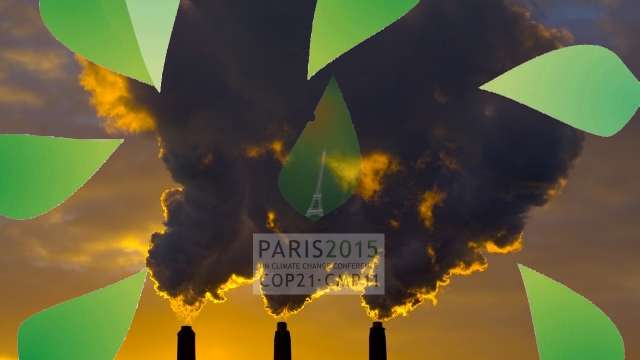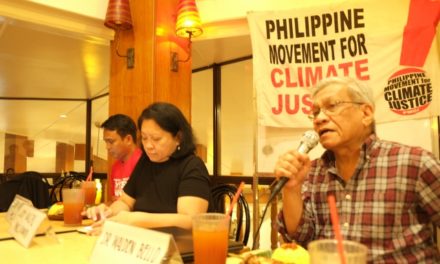The future lies in the past. What has happened will determine what will come. The idea that we can change everything and save the world at the last minute is exciting in movies but it does not work in real life. It particularly applies when we speak about issues like climate change where the consequences of what we did in the past century are just beginning to manifest.
This principle applies also to climate negotiations. What is now on the table after the climate negotiations held in Geneva from 8-13 February 2015 is setting the scope and the range of possibilities for the climate agreement at the upcoming COP 21 in Paris this December.
The good news
The good news is that in Geneva the climate negotiations have finally really started. Smoothly and quickly, delegations from different countries avoided long speeches and went directly to work to compile their different proposals for a future climate agreement in Paris. At the moment, the negotiating text has 86 pages and 1,273 brackets. The task for the next 10 months is to streamline this bracketed draft and come out with a text of around 20 pages without annexes and zero brackets.
In the current text there are good and bad proposals that yet need to be negotiated and agreed. The final result will be something in between the most ambitious and the weakest proposals. So how good are the more positive proposals on the table? Are they going to put us on a path that limits the increase of the temperature to 1.5 ºC or 2 ºC?
Disturbing omissions
By now, it is well known that to achieve the goal to limit the temperature increase to below 2ºC, we need to leave 80% of the current known fossil fuel reserves under the ground. This has been stated in many studies, reports and interventions, but not one single country has submitted this proposal in the current text of negotiations. The word “fossil fuels” only appears twice throughout the text and only in reference to the reduction of fossil fuel subsidies. How are we going to cut back greenhouse gas emissions if we don’t have an agreement to leave under the soil, the 80% of the “black gold” that has been discovered?
The other disturbing omission is the short-term target for 2025 and 2030. In the text there are 13 references to zero emissions by the mid and end of the century. But when it comes to this decade and the next, there are no concrete targets and just general references about “enhancing the mitigation ambition” that appears 61 times in the text. The targets that are needed are very clear in different studies. The UNEP Emissions Gap report and other studies show that to be consistent with a trajectory that limits the increase of the temperature to 2ºC, global greenhouse gas emissions have to be reduced to 44 Gigatons (Gt) of CO2e by 2020, 40 Gt by 2025 and 35 Gt by 2030. This is the cap the world needs to avoid a future too dire to imagine. Now, in the text there are no references to these figures. There are only proposals in terms of percentages for the next half of the century. The most ambitious for the near term says, “Developed country Parties shall take mitigation commitments for the post-2020 period that are more ambitious than emission reductions of at least 25–40 per cent below 1990 levels by 2020”. In other words, the next decade you have to be more ambitious than this decade. That is not really a clear target.
These omissions in the text are not an accident, they reflect an agreement that for the coming years until 2030, every country will do what they can/want and the UNFCCC will just summarize the “intended nationally determined contributions (INDCs)”. No single country has challenged this suicidal path by putting in the negotiating text that we need a global target to reduce global emissions to only 40 Gt of CO2e by 2025 to avoid an increase in the temperature of 4ºC to 8 ºC.
The center of the debate?
Looking at the negotiating text, it is clear that what seems to be the center of the controversy is not about how much to reduce greenhouse gas emissions, but around the supposed conflict between developed and developing countries. The word “development” appears 247 times in the negotiating text, “developing” countries 410 and “developed” countries 342 times. The debate in the text is more about who should do what in the reduction of green house gas emissions (developed and developing), what flexibility mechanisms (carbon markets) are going to be in place, how each one is going to report, what kind of verification process will be established for the different type of countries and what kind of financial and technological support there will be to implement the mitigation actions.
The position of developed countries in general tends to water down the difference between developed and developing countries, promoting more the use of “all parties” (134 mentions in the text). On the other hand, developing countries want to keep the firewall between developed and developing countries.
The group of Like-Minded Developing Countries (LMDC) that includes Algeria, Argentina, Bolivia, Cuba, China, Democratic Republic of the Congo, Dominica, Ecuador, Egypt, India, Iran, Iraq, Kuwait, Libya, Malaysia, Nicaragua, Pakistan, Qatar, Saudi Arabia, Sri Lanka, Sudan, Syria and Venezuela has included the following paragraphs in the negotiating text that show their approach to developed and developing countries:
“Developed country Parties shall commit to undertake Absolute Emission Reduction Targets during the period of 2021-2030, in accordance with a global emission budget including their historical responsibility, through quantifiable, economy-wide mitigation targets, covering all sectors and all greenhouse gases, implemented mainly domestically, which can be aggregated and which are comparable, measurable, reportable and verifiable, with the type, scope, scale and coverage more ambitious than those undertaken under the Convention and its Kyoto Protocol during the pre-2020 period, and communicated and implemented without any conditions”.
On the other hand, “Developing country Parties should commit to undertake Diversified Enhanced Mitigation Actions (DEMAs) during the period 2021–2030. They may include, inter alia, relative emission reductions; intensity targets; REDD-plus activities and other plans, programmes and policies; joint mitigation and adaptation approaches; net avoided emissions, or also manifested as adaptation co-benefits, in accordance with their special circumstances and specific needs.”
While it is true that this is a real source of debate – the maintenance of the delineation between developed and developing countries so that developed countries do not escape their historic responsibility, and that countries make commitments according to common but differentiated responsibility, it is also one that serves as a smokescreen for the deals that have been made between polluters – one developed and one developing. China, which has caught up to developed countries on levels of emissions, maintains the developing country title but does the rest of the developing countries a disservice by striking a very bad deal with one of the largest polluters in the world, the United States. The highly publicized US-China deal last year is a reflection of how the US and China, two of the largest polluters, have decided not to do what is needed for 2025/2030. The two big polluters account for more than 40% of global greenhouse gas emissions. This is a “laissez faire” deal in which China will only peak (reduce in absolute terms) emissions in 2030 and the US will reduce 15% of their green house gas emissions in 2025 based on their level of emissions in 1990. As a reference, the EU has committed to reduce 40% of their emissions by 2030 based on their 1990 levels.
This is the heart of the deal in Paris and with these emission cuts from the US and China, the rest of the countries will not do much more because as they have expressed, that would go against their competitiveness in the global economy. The negotiation around the text is about how to package and sell a bad deal to public opinion and how to dilute the responsibility of polluting countries of the developed and the emerging developing world. Probably the issue about “common but differentiated responsibility” will be solved through the addition of some “innovative language” like “in light of different national circumstances” as it happened in COP20 in Peru.
Opening the door for new carbon markets
Even with the failure of carbon markets, the debate is not if this mechanism should continue or not, but how to enhance the current ones and develop new ones. No country has submitted text to avoid carbon market mechanisms or REDD+. Carbon market mechanisms are mentioned 27 times and REDD+ 13 times. In the text there are mentions of an “enhanced Clean Development Mechanism (CDM+)”, the “Emissions Trading System (ETS)”, “REDD Plus”, “market mechanism in the land use sector”, “sub-national and regional emissions schemes” and “carbon pricing”. A reading of the text shows that COP 21 will open the door for new carbon market mechanisms but that the real development of them will be agreed at future COPs.
Finance: the forgotten promise
Finance, which was supposed to be one of the most crucial commitments by the developed countries to the developing countries, has now become an issue relegated to the sidelines. The climate debt owed to those suffering the impacts of climate change, yet who are the least responsible, is on the way to being forgotten. Looking at the text, the word finance itself is mentioned 203 times but when it comes to concrete figures, there are only a measly 14 mentions with only four proposals:
- [Developed countries][All countries in a position to do so] commit to provide at least USD 50 billion per year during the period from 2020 to 2025, at least USD 100 billion per year by [2020][2030] for adaptation activities of [developing countries].
- The provision of finance committed by developed country Parties to be based on a floor of USD 100 billion per year since 2020.
- A short-term collective quantified goal of USD 200 billion per year by 2030 should be committed by developed country Parties,
- [Developed country Parties][Parties in a position to do so, considering evolving capabilities] to provide 1 per cent of gross domestic product per year from 2020 and additional funds during the pre-2020 period to the Green Climate Fund (GCF)
If current promises are to be a basis, there is little confidence in these promised numbers. At the COP20 in Lima, there was triumph around the achievement of reaching 10 billion USD – out of the 100 billion USD that was originally promised several COPs ago.Furthermore, in the text, developed countries prefer to use the term “mobilize” instead of “provide” and they do not limit the obligation of funding to developed countries but to all countries in a position to do so, further diluting the responsibilities of the developed countries as they spread it to developing countries. The term “mobilize” is not associated with any figure in particular and in general includes “from a variety of sources, public and private, bilateral and multilateral, including alternative sources” which means that even loans and carbon markets will be accounted in the process of mobilization of financial resources.
Rights and compliance
Human rights are mentioned seven times and mainly in the preamble and objectives section. There are no concrete proposals to guarantee human rights in mitigation, finance, market or technology measures. There is only one mention in adaptation and only in general terms. In some cases, the mention of human rights is at the same level as the right to development. Indigenous peoples’ rights appears only two times in the preamble. Migrant rights are not included, and in the loss and damage chapter, there are only two mentions of “organized migration and planned relocation”. The proposal of Rights of Mother Earth or Rights of Nature is not included at all as an option to be discussed. The only mention to Mother Earth is in relation to “protecting the integrity of Mother Earth” without further development.
When it comes to mechanisms of compliance, there are those that say, “no specific provisions required” and those that suggest a “Compliance Committee” with “an enforcement branch and a facilitative branch”. The possibility of sanctions is mentioned and also suggested is the “use of economic instruments such as market mechanisms as a way to promote compliance”. Bolivia has included the proposal for an “International Climate Justice Tribunal”.
These token mentions of rights and recognition of those at the frontlines of climate change are empty promises with no concrete commitments attached to them. The negotiations around solutions to climate change need to have the rights of peoples and Nature at its heart.
Fighting for our Future now, not in Paris
The nature of climate change with its feedback mechanism is such that what we did in the past is what we reap now. Following this logic, what we do now is what we will reap in the next 10 years, and if the current text is to be the basis of that future, we will have none of which to speak.
There is no cheating, buying or creating loopholes to delay action until 2030 – the time to act decisively is now. And these are very concrete and clear actions that need to be taken:
- leave 80 percent of the known fossil fuels reserves under the ground
- deep emissions cuts to achieve global targets – 44 Gigatons (Gt) of CO2e by 2020, 40 Gt by 2025 and 35 Gt by 2030
- reduce military and defense expenditures, which account for more than 1.5 trillion dollars globally, and instead channel these funds to provide public finance for developing countries for adaptation, mitigation and for loss and damage
- the recognition, respect and promotion of the rights of people and nature
A bad deal in Paris will lock in catastrophic consequences for the future of the planet and humanity. The urgency of the task at hand cannot be emphasized enough – we need to act now.
Pablo Solón is Executive Director of Focus on the Global South.









